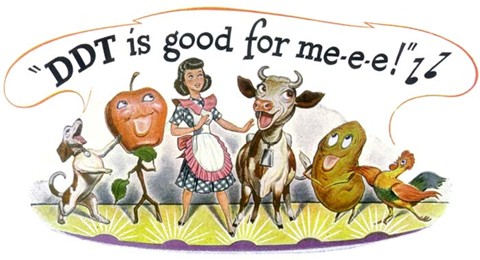
Yesterday’s post about temperance medals somehow got the Microkhan community meditating upon whether DDT deserves to have its reputation rehabilitated, at least as a malaria fighter. The revisionist stance these days is that the chemical should be used to combat the disease “when no other effective, safe and affordable alternatives are locally available.” That doesn’t mean that DDT is safe, but rather that the risks it poses are less harmful than allowing malaria to run rampant. And so you end up with situations like that in eastern and northern Uganda, where the government has decided that DDT is its only viable option:
THE Government will soon start residual spraying of DDT to kill mosquitoes that cause malaria. Health state minister James Kakooza yesterday said sh7b had been earmarked for the exercise in the next financial year’s budget.
Speaking at a press conference at the Media Centre in Kampala, Kakooza said DDT will be sprayed alongside Icon, so as to bring down the prevalence of the deadly disease from the current prevalence rate of 25% to between three and five percent by 2015.
DDT, Kakooza said, would be sprayed, starting with areas with a high malaria prevalence, such as Kabale and parts of eastern and northern Uganda. He defended the use of DDT, saying it was not known to have any side effects on humans.
The decision to start spraying DDT comes two years after the High court banned the spraying of the chemical, following allegations that it could kill about 320 people daily.
The Government, however, won the court case and will once again embark on the exercise.
The minister’s argument is obviously a bit disingenuous, but we understand where he’s coming from. People don’t want to hear that meaningful solutions can have terrible consequences, a truism that probably explains 75 percent of political lies the world over.
More on DDT and malaria next week. We’ve got some reading to do this weekend.
(Image via Mindfully.org)


Jordan // Jun 4, 2010 at 10:30 am
I think the situation is fairly analogous to that of a group that was providing chemical sterilization in developing countries. The drug they were using had been banned by the FDA because of carcinogenic effects. So the question became, is it worth an increased risk of cancer to avoid an increased risk of death from childbirth? We seem to have a hard time grappling with these kinds of moral calculus questions in public.
scottstev // Jun 4, 2010 at 11:46 am
Jordan, is chemical sterilization used as an expedient to surgical? I’ve never heard of it being used in a non-coercive fashion in the US (Sex-Offender treatment currently, and during the Eugenics era in the past).
Brendan I. Koerner // Jun 4, 2010 at 1:35 pm
@Jordan: Yeah, hit me with a link to that if you have one handy. I think I initially misread your comment and thought the NGO was simply providing doctors with chemicals to sterilize medical instruments. But you’re actually talking alternative to hysterectomy/vasectomy, right?
Couldn’t agree more on your observation re: the difficulty in making such choices. It reminds me of those movies where the villain is holding the hero’s girlfriend/wife/daughter hostage, and won’t let her go until he’s killed thousands of innocent people as part of some evil masterplan. The cold logic there would dictate that the lives of many outweigh the lives of one. But filmmakers get around that moral dilemma by just having the hero stage an elaborate rescue. The real world, alas, doesn’t offer such neat solutions.
The Oaxacan Example // Jun 7, 2010 at 10:29 am
[…] on with our promised examination of DDT’s usefulness in the War on Malaria, we’re gonna turn our gaze southward this […]